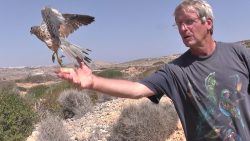BirdLife Malta is very happy to announce that after weeks of rehabilitation, a male and a female Common Kestrel (Spanjulett) were in the past days released in Comino.
The male, nicknamed ‘Baal’, after the Phoenician God known as ‘rider of clouds’, was found in Żejtun in July with gunshot injuries that left him grounded with a broken wing. After our amazing vets examined him and had a look at how the fracture would heal, we together decided to attempt rehabilitation. It took a few days for Baal to get used to captivity – a necessary measure in order for him to be fed and kept safe during his recovery – but he quickly started feeding on his own and using the provided perches.
The juvenile female Common Kestrel ‘Tanit’, named after the Phoenician Mother Goddess, was retrieved in Qormi on the 8th of August, showing signs of illegal captivity. She could not fly but made a very quick recovery, and was ready to be released after a month of rehabilitation.

Baal, the male Common Kestrel, taking off (Photo by Iryna Lukashuk)
In both cases, the birds were handed over to BirdLife Malta after vets declared that although they suffered injuries, they could be rehabilitated after a few weeks. The vets were in constant touch with BirdLife Malta to make sure that the birds were progressing well. We also made sure to keep contact with humans at the bare minimum so they would not get habituated to people, but it became very clear that they didn’t like us one bit anyway, which is very good!
Before taking off, both Baal and Tanit were ringed by qualified bird ringers Roger and Helen Short of the Comino Birds Observatory who are carrying out ringing and monitoring activities as the bird migration picks up.
Common Kestrels (Falco tinnunculus) are small raptors belonging to the falcon family, and are best recognised by the hovering behaviour they display when hunting for small rodent prey. They are usually seen hunting over fields and have very keen eyesight, allowing them to spot their prey from up to 20m above the ground. Common Kestrels are cavity nesters, so they will typically nest in holes on cliffs, trees or even buildings. Whilst many Common Kestrels are resident to where they breed, those breeding in cooler climates in northern Europe move to warmer climates in the winter, and can easily be seen on migration over Malta in spring and autumn.

Tanit, the juvenile female Common Kestrel released in Comino (Photo by James Symonds)
Given the time of the year, it is possible that Baal was breeding in Malta when he was shot down, and it is just as likely that Tanit hatched in Malta during last breeding season. Both birds were brought to BirdLife Malta by members of the public and were unable to fly after sustaining human-inflicted injuries, but have made spectacular recoveries and have been given a second chance to live freely in the wild.
Birdlife Malta is aware of at least two successful breeding attempts by kestrels on the Maltese Islands this year, and hopes to see similar successes from pairs next year.
Commenting on the rehabilitation and release of both Common Kestrels, BirdLife Malta CEO Mark Sultana said: “I am proud to have a team of dedicated staff and volunteers that need to be given credit for this work. Whilst we hope that illegally shot birds continue to reduce, we will always be willing to share our expertise, knowledge and resources for the benefit of birds and nature. BirdLife Malta’s vital work, including the rehabilitation and release of birds, requires ongoing support and funding to ensure it can continue long into the future. Those who would like to support us can become a member by visiting https://birdlifemalta.org/become-member.”
Read the Maltese version of the press release here. You can also watch footage of the release of Baal here and of the release of Tanit here.
